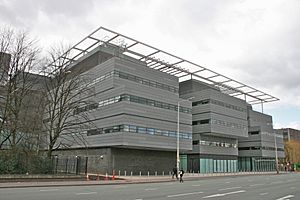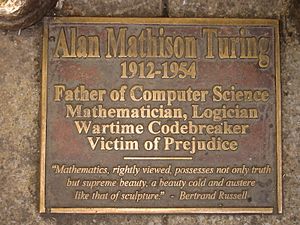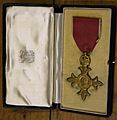Alan Turing facts for kids
Quick facts for kids
Alan Turing
|
|
|---|---|

Turing in 1951
|
|
| Born |
Alan Mathison Turing
23 June 1912 Maida Vale, London, England
|
| Died | 7 June 1954 (aged 41) Wilmslow, Cheshire, England
|
| Alma mater | |
| Known for |
|
| Awards | Smith's Prize (1936) |
| Scientific career | |
| Fields |
|
| Institutions |
|
| Thesis | Systems of Logic Based on Ordinals (1938) |
| Doctoral advisor | Alonzo Church |
| Doctoral students |
|
| Signature | |
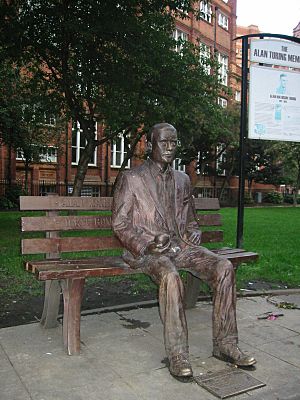
Alan Mathison Turing was a brilliant English mathematician and computer scientist. He was born in Maida Vale, London, on June 23, 1912. Turing is famous for his important work with computers and for helping to break secret codes during World War II. He passed away in Wilmslow, Cheshire, on June 7, 1954.
Contents
Early Life and Education
Where Did Alan Turing Grow Up?
Alan Turing was born in London while his father was working in India. His parents wanted their children to grow up in Britain. So, they moved to Maida Vale, London, where Alan was born.
Alan had an older brother named John. During his childhood, Alan's parents often traveled between the UK and India. Alan and his brother stayed with a retired Army couple.
From a very young age, Alan showed signs of being extremely smart. His teachers noticed his special talent. One headmistress even said, "Alan is a genius."
What Was Turing's School Life Like?
Turing went to primary school from age six to nine. Later, he attended Hazelhurst Preparatory School. In 1926, at 13, he went to Sherborne School, a boarding school.
On his first day, there was a big strike in Britain. But Turing was so determined to get to school that he rode his bicycle 60 miles (97 km) to Sherborne! He even stopped overnight at an inn.
Some teachers at Sherborne didn't appreciate his love for math and science. They thought other subjects were more important. But Turing kept showing amazing skill in the subjects he loved. By age 16, he was understanding Albert Einstein's complex ideas.
Who Was Christopher Morcom?
At Sherborne, Turing became very close friends with another student, Christopher Morcom. Christopher was a big inspiration for Turing. Sadly, Christopher died in 1930 from an illness.
This event made Turing very sad. He dealt with his grief by working even harder on science and math. These were the subjects he had shared with Christopher. Turing wrote to Christopher's mother, saying how brilliant and charming his friend was. He believed Christopher would want him to keep working hard.
Turing's friendship with Christopher's mother continued for many years. He would send her letters, especially around Christopher's birthday.
How Did Turing Study Computers?
After school, Turing studied at King's College, Cambridge, from 1931 to 1934. He earned top honors in Mathematics. In 1935, at just 22, he became a Fellow of King's College. This was because of his excellent work in math.

In 1936, Turing published a very important paper. In it, he described a theoretical machine. This machine could perform any mathematical calculation if it was given step-by-step instructions. This idea became known as the Turing machine. It was a big step towards modern computers.
Turing also showed that some problems cannot be solved by any computer. This paper is considered one of the most important math papers ever.
His ideas were similar to those of another mathematician, Alonzo Church. But Turing's idea of a "Universal Machine" was easier to understand. This Universal Machine could do the work of any other computing machine. Today, Turing machines are still studied in computer science.
From 1936 to 1938, Turing studied at Princeton University in the United States. He earned his PhD there. He also built parts of an early electronic calculator.
Turing's Career and Impact
What Was the Turing Machine?
Turing was one of the first people to work on the idea of computers. In 1936, he created the theoretical Turing machine. This machine was imaginary, but it showed the idea of a computer program. It helped people understand how computers could work.
What is the Turing Test?
Turing was also interested in artificial intelligence (AI). He came up with the Turing test. This test helps decide if a machine can be called "intelligent." If a human talks to a computer and can't tell it's a machine, then the computer might be considered to "think."
How Did Turing Help in World War II?
During World War II, Turing worked with others to break secret German messages, called ciphers. He worked for the Government Code and Cypher School (GC&CS) at Bletchley Park. This was Britain's secret code-breaking center.
Using his skills in cryptanalysis (code-breaking), he helped to crack the codes of the Enigma machine. This machine was used by the German military to send secret messages. Breaking these codes was a huge help to the Allies during the war.
What Did Turing Do After the War?
From 1945 to 1947, Turing worked on designing one of the first electronic computers. It was called the ACE (Automatic Computing Engine). He wrote a detailed plan for this computer. It was the first plan for a "stored-program computer." This means a computer that could store its instructions inside itself.
Even though there were delays, a smaller version called the Pilot ACE was built. It ran its first program in 1950.
Later Life and Recognition
What Challenges Did Turing Face?
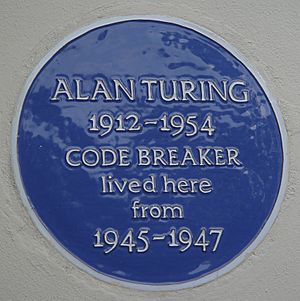
In 1952, Alan Turing faced legal challenges because of laws at the time. Because of this, he could no longer work for the government on code-breaking.
Turing passed away a couple of years later at the age of 41.
In 2013, almost 60 years later, Turing received a Royal Pardon from Queen Elizabeth II. This means his past legal issues were officially forgiven. Today, a law called the "Turing law" automatically pardons other men who faced similar legal issues in the past.
Awards and Tributes
Turing received many honors for his work. In 1946, he was made an officer of the Order of the British Empire. In 1951, he was elected a Fellow of the Royal Society, which is a very high honor for scientists.
The city of Manchester, where he worked, has honored him in many ways.
- A road is named "Alan Turing Way."
- A bridge is named "Alan Turing Bridge."
- A statue of Turing was put up in Sackville Park in 2001. The statue shows him sitting on a bench, holding an apple.
In 1999, Time magazine named Turing one of the "100 Most Important People of the 20th Century." They said that anyone who uses a computer keyboard is using a version of a Turing machine.
Alan Turing will also be featured on the Bank of England's highest-value banknote, the £50 note. It is expected to be in circulation by the end of 2021.
Images for kids
-
Two cottages in the stable yard at Bletchley Park. Turing worked here in 1939 and 1940.
-
A blue plaque on the house at 43 Adlington Road, Wilmslow where Turing lived and died.
See also
 In Spanish: Alan Turing para niños
In Spanish: Alan Turing para niños



